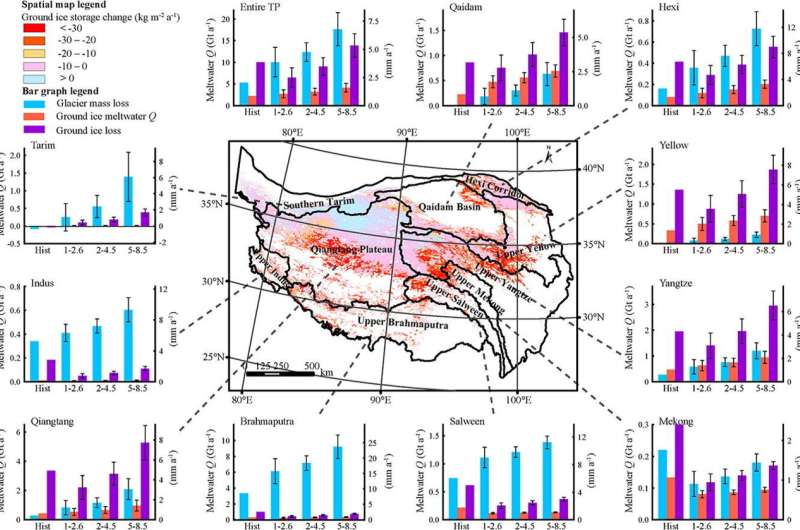This article has been reviewed according to Science X's editorial process and policies. Editors have highlighted the following attributes while ensuring the content's credibility:
fact-checked
trusted source
proofread
Considerable but unsustainable water supply from thawing permafrost on the Tibetan Plateau in a changing climate

In a warming climate, the sustainability of cryospheric meltwater on the Tibetan Plateau has raised concerns because of its importance for the fragile ecosystem in the headwater regions and the dense populations in the downstream. Existing studies mainly focused on glacier melt and snow melt on the Tibetan Plateau, which are above the ground surface can be detected from the surface using in-situ or satellite observations. However, the hydrological implications of thawing permafrost below the ground surface remain largely unknown.
This study was led by Dr. Taihua Wang and Dr. Dawen Yang (Tsinghua University), together with experts in the field of both permafrost and glacier including Dr. Tandong Yao, Dr. Xin Li (Institute of Tibetan Plateau Research, Chinese Academy of Sciences), Dr. Guodong Cheng and Dr. Huijun Jin (Northwest Institute of Eco-Environment and Resources, Chinese Academy of Sciences).
"For the study of permafrost hydrology changes, the ground surface observations have to be combined with physically-based models to examine what is happening below the ground surface," Taihua says. Therefore, a hydrological model that could reflect the complex interactions between cryospheric and hydrological processes is urgently needed.
The research group led by Dr. Dawen Yang has endeavored to develop such a model for years. Twenty years ago, Dr. Dawen Yang developed a distributed hydrological model named "Geomorphology-Based Hydrological Model (GBHM)". In 2010, Dr. Dawen Yang participated in a major research plan entitled "Integrated research on the eco-hydrological process of the Heihe River Basin" led by Dr. Guodong Cheng.
With the support of the research plan and collaboration with experts from different disciplines, the distributed Geomorphology-Based Ecohydrological Model (GBEHM) was developed, which could simulate the coupled water-heat processes and has been successfully applied in many headwater regions of the Tibetan Plateau.
Another challenge of relevant study is the limited data on the Tibetan Plateau. Thanks to recent accumulation of both in-situ and satellite observations, as well as the enhanced geoscience data sharing through platforms like the National Tibetan Plateau Data Center led by Dr. Xin Li, the simulation can be applied to the entire Tibetan Plateau with an unprecedented high spatial resolution (1 km × 1 km).
The results from the modeling study provide some novel insights into the magnitude and temporal changes of water supply from thawing permafrost and melting ground ice. Combining in-situ borehole observations with the spatial distribution of depositional types and paleo-precipitation information, the average ground ice storage across the Tibetan Plateau is estimated to be about half the size of glacier ice storage.
However, the ground ice storage decline was almost twice the amount of glacier mass loss during 1980-2019, indicating a more severe decline in the subsurface ice reserve than the above-surface one at the plateau scale, although the former one has received much less attention.
By tracing the meltwater flow paths, the study also quantifies the ground ice meltwater contribution to river runoff. Despite the relatively small contribution at the plateau scale (~0.5%), the ground ice meltwater runoff can be locally important and larger than that from glacier melt in many sub-regions including the upper Yellow, the upper Yangtze and the Qiangtang Plateau.
However, the meltwater runoff from thawing permafrost is unsustainable over the coming decades, which could possibly threaten water security in certain regions relying on water supply from thawing permafrost. "This is similar to previous findings of unsustainable meltwater supply from glaciers on the Tibetan Plateau. The impacts could be more evident in arid regions and dry years, and we have to get prepared for this additional risk caused by unsustainable cryospheric meltwater supply," Taihua says.
Despite uncertainties in the results of the study, the findings highlight the rarely examined yet non-negligible role of permafrost thaw and ground ice meltwater for the Asian water tower. In the future, high-resolution remote sensing observations and more publicly available in-situ observations across the Tibetan Plateau can be adopted to further reduce the uncertainty in the estimates.
The impact of unsustainable cryospheric meltwater on the fragile alpine ecosystem and regional carbon budget on the Tibetan Plateau can also be examined by future studies.
The findings are published in the journal Science Bulletin.
More information: Taihua Wang et al, Unsustainable water supply from thawing permafrost on the Tibetan Plateau in a changing climate, Science Bulletin (2023). DOI: 10.1016/j.scib.2023.04.037
Provided by Science China Press




















